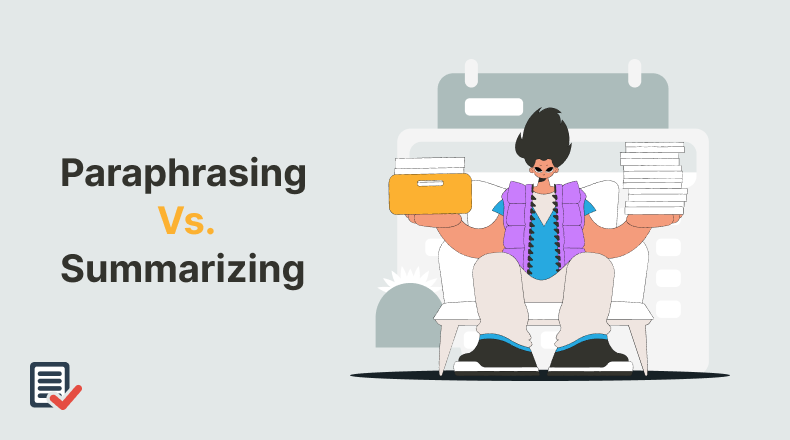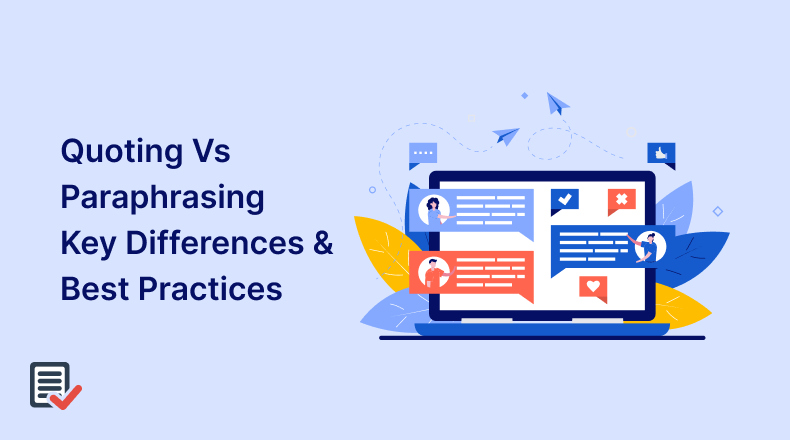
Paraphrasing and summarizing are two essential techniques that many writers and students often rely on, yet they serve very different purposes. Understanding how to use them correctly can significantly affect how effectively we communicate ideas.
However, paraphrasing involves rewording content to maintain its original meaning. Meanwhile, summarizing is all about condensing the information to its most critical points. Each technique requires its own approach, and knowing when to use one over the other is the key.
In this blog, we will discuss the basic differences between these essential techniques and explore how and when to use these techniques.
Paraphrasing and Summarizing – Comparison
To get a better grip on writing, it is essential to learn how to paraphrase and summarize. But what do these skills actually do to the text? We will be breaking the two of these techniques in the following.
Paraphrasing
According to the Oxford Dictionary, the word paraphrase is defined as “a statement that expresses something that somebody has written or said using different words, especially to make it easier to understand.”
This definition clearly explains that this technique is used to clarify the text and make it more readable and understandable. By paraphrasing, writers can adapt the tone, change the wordings, add clarity, and improve the sentence structure of their content. By rephrasing content, you can add a unique touch while communicating the same message.
Summarizing
Summarizing, on the other hand, is a short form of text that is extracted from relatively detailed content. As defined in the Oxford Dictionary, a summary is “a short statement that gives only the main points of something, not the details.”
The summarizing technique is used to sum up everything in a brief paragraph. The goal is to extract the core concepts of a long piece of writing while leaving out unnecessary details.
Paraphrasing Vs. Summarizing – The Key Differences
While paraphrasing and summarizing involve restructuring the content, they serve different purposes and follow distinct approaches.
• Length
When paraphrasing, the original length is retained because the focus is on rewording the content without ignoring essential details.
While summarizing, the goal is to present the main points concisely, removing less relevant information.
• Purpose
The main purpose of paraphrasing is to clarify or restate an idea in a new way. This technique is often used to improve readability, integrate the content into your own writing, or avoid plagiarism while maintaining the depth of the original message.
Summarizing aims to condense the information. It provides an overview and gives readers a quick understanding of the key ideas without diving into every detail. This is useful when the primary goal is to present a brief text version.
• Level of Detail
Paraphrasing retains much of the detail from the original text while using different wording.
On the other hand, summarizing presents a broad overview rather than a detailed breakdown by removing less essential information.
• Structure
When paraphrasing, you usually maintain the pattern of the original text. The flow of ideas remains the same; only the wording and sentence structure change.
Summarizing often involves reorganizing the content. Since you’re reducing the text to its key points, the structure becomes more flexible and focuses only on the most important ideas.
Examples of Paraphrasing and Summarizing
Let’s consider an example to distinguish between these two techniques. We will paraphrase and summarize the following paragraph.
Original Text:
Mental illness can have a profound impact on human health. It affects both physical and emotional well-being. Individuals struggling with mental conditions may experience a range of symptoms, including fatigue, insomnia, changes in appetite, and difficulty concentrating. These symptoms can lead to decreased quality of life, impaired relationships, and increased vulnerability to chronic illnesses. Additionally, mental health conditions can significantly increase the risk of suicide, making it a severe public health concern.
Paraphrasing Example:
Human health can be severely impacted by mental illness. It has an impact on both physical and mental well-being. People who struggle with mental health issues might exhibit a variety of symptoms, such as exhaustion, sleeplessness, eating disorders, and trouble focusing. These symptoms may result in a lower standard of living, interpersonal conflicts, and an increased vulnerability to long-term diseases. In addition, mental health condition is a major issue for the community because it can considerably raise the risk of suicide.
Summarizing Example:
Mental illness significantly impacts human health, causing symptoms like fatigue, insomnia, and concentration difficulties. It can lead to decreased quality of life, impaired relationships, increased vulnerability to chronic illnesses, and increased suicide risk.
How to Paraphrase and Summarize?
There are multiple approaches to paraphrasing and summarizing any written content. We will be discussing these methods separately.
Paraphrasing Techniques
Paraphrasing involves enhancing your written work, removing errors, or refining the tone to improve readability.
Here are some effective strategies to paraphrase the content without changing the context.
- The most common technique is to use simpler terms in place of complex words. This method uses synonymous words to keep the actual meaning intact.
- Varying the sentence structure to alter the grammatical composition also works to rephrase the content. It simply means changing the voice of a sentence to convey the same message differently.
- This method also involves splitting or merging phrases or clauses to make a different sentence.
Pro Tip: Want to quickly and accurately paraphrase your text? Try using our AI-powered free paraphrasing tool.
Summarizing Techniques
Summarizing involves condensing the information. It is a step-by-step process, so here’s how you can do it.
- First, read all the text to understand the exact meaning of the content. In this part, you will be able to detect the main idea, so read it several times.
- Highlight the main events or points that support the main idea.
- Write down all the main ideas in your own words. Just focus on the important points and leave all the details.
- Make an outline to create a link between these points.
Pro Tip: Use the AI summarizer, as it saves time and reduces manual effort.
When to Paraphrase and Summarize?
Now, you would wonder how to decide which technique to use.
Well, it depends on the length of the original content. If the text to be rewritten is concise and to the point, use the paraphrasing technique. It will help you to focus on all the aspects and retain all the necessary details.
The most common uses of paraphrasing include:
- Adding details from multiple sources.
- Simplifying a lengthy and complex text.
- Explain the text from a different angle on previously discussed topics.
- Enhancing the quality of content.
- Improving the writing style or tone of the content.
- Presenting information in an interesting way.
For long-form content, choose the summarizing technique. It will help you to extract only the important points from the lengthy text. Summarizing works better than paraphrasing when you want to reduce the word count.
- Writing an introduction or conclusion to a subject.
- Reducing the reading time of any content.
- Packing all the information in a small paragraph.
- Communicate the essence of a long or complicated material.
- Highlight the key points in any document, speech, or presentation.
Wrapping Up:
Mastering the art of paraphrasing and summarizing can enhance your writing by giving you more control over how you present information. Paraphrasing allows you to retain the originality of the text, while summarizing offers a quick overview of all the main points. Knowing the difference between the two is a skill.
These skills will improve the clarity and accuracy of your work. By applying each technique wisely in your written work, you can communicate more effectively and tailor your message to fit the context perfectly.







